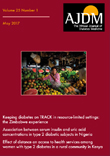Gist of Type 2 diabetes and its effects in day to day life
*Corresponding Author:
Received: 02-Nov-2021 Accepted Date: Nov 16, 2021 ; Published: 23-Nov-2021
Type 2 diabetes is an impairment in the way the body regulates and uses sugar (glucose) as a fuel. This longterm (chronic) condition results in too much sugar circulating in the bloodstream. Eventually, high blood sugar levels can lead to disorders of the circulatory, nervous and immune systems. In type 2 diabetes, there are primarily two interrelated problems at work. Your pancreas does not produce enough insulin, a hormone that regulates the movement of sugar into your cells — and cells respond poorly to insulin and take in less sugar.
Type 2 diabetes is a common condition that causes high blood sugar (glucose) levels. May cause symptoms such as excessive thirst, excessive urination and malaise. It can also increase the risk of serious eye, heart and nerve problems. It is a lifelong condition that can affect your daily life. You may need to change your diet, take medication, and have regular health checkups. The cause is a problem with a chemical (hormone) in the body called insulin. It is often associated with an overweight or sedentary lifestyle, or a family history of type 2 diabetes. Type 2 diabetes is characterized by hyperglycemia and consists of a series of disorders resulting from a combination of resistance to insulin action, inadequate insulin secretion, and excess or inadequate glucagon secretion. If you are overweight, you can take steps to prevent or delay type 2diabetes by losing weight, reducing calories, and energizing your body. If you have a condition that increases your risk of type 2 diabetes, treating that condition may reduce your risk of type 2 diabetes. Diet is an important tool to help maintain optimal heart health and blood glucose levels that are within a safe range.
The diet recommended for people with type 2 diabetes is the same diet just about everyone should follow. It boils down to a few key actions: Choose a variety of foods that are high in nutrients and low in empty calories. Work on being mindful about portion sizes and stopping eating when you’re full. Read food labels closely to understand the amount of sugar or carbs you could be ingesting in a serving size. Diet is an important tool for keeping optimal heart health and blood sugar levels within safe limits. The recommended diet for people with type 2 diabetes is the same diet that most people should follow. It is summarized in a few important actions: Choose a variety of nutrient- rich, empty calorie-free foods. Pay attention to the size of the potion and try to stop eating when you are full. Carefully read the food label to understand the amount of sugar or carbohydrate you may consume in a single serving. Symptoms of type 2 diabetes often develop slowly— over the course of several years—and can be so mild that you might not even notice them. Many people have no symptoms. Some people do not find out they have the disease until they have diabetesrelated health problems, such as blurred vision or heart disease.





